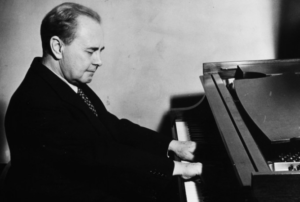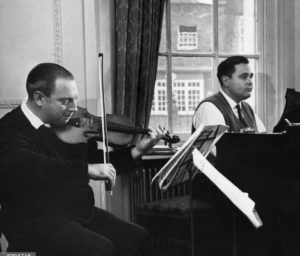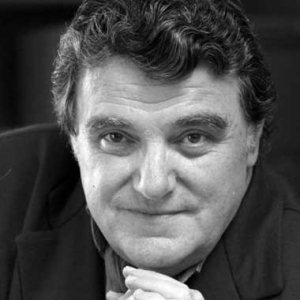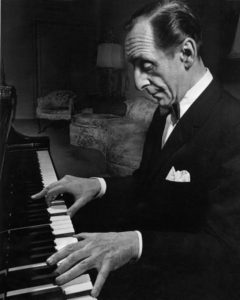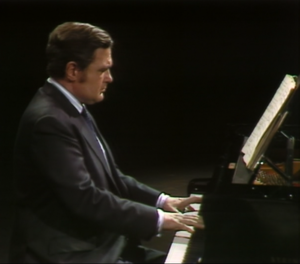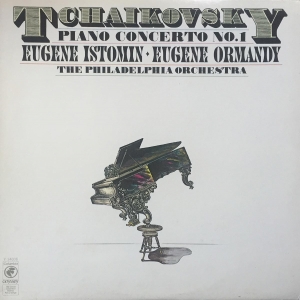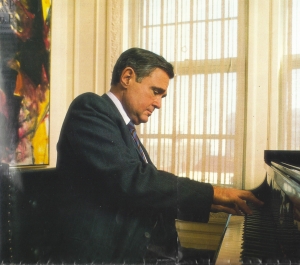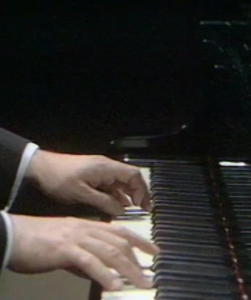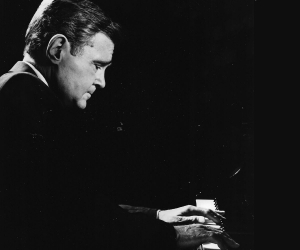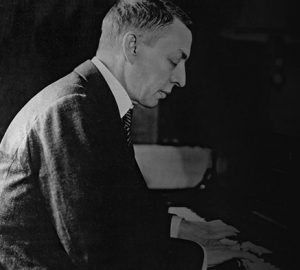PLAYING THE PIANO
“He had a very beautiful tone which was immediately recognizable due to the quality of the attack. His playing had a crystal-clear sound and the phrasing was uniquely personal. He was a kind of extra-terrestrial musician. He was deeply attached to Mozart’s classicism, but attained the utmost limits of virtuosity in the Rachmaninoff Second Concerto. He could give the feeling of a perfect legato even while attacking each note separately. For a long time, he relied on his natural ease of playing, but this eventually caused him trouble, and he was forced to question himself and rethink his practicing.” This is how Jean-Bernard Pommier describes his master and friend. Istomin rarely talked about his practicing except with Pommier, who never ceased to bombard him with questions and new ideas.
If one thinks of Istomin in terms of a particular piano school, we should refer back to the old Russian school embodied by Siloti and Hofmann: powerful playing with a touch reaching “to the bottom of the keys”, but which was capable at the same time of light-handedness and above all, of great suppleness. It was a far cry from the later Russian school, that of heavy-handed bangers. Istomin’s full and singing tone (with its bell-like timbre so beloved of Rachmaninoff and Horowitz), combined with his search for tone color, was the opposite of Richter’s, who was mainly concerned with the outline.
.
The obsession with singing
“My vocation as a musician came from singing -that of my parents and also of the great singers they frequently listened to at home.” When he first began playing the piano, Istomin initially imitated the Russian folksong melodies and Italian opera arias which he had heard his parents singing, but very soon he began trying to accompany them, making up arpeggios and inventing harmonies which supported and enhanced the melodic line. This was enough for Siloti to realize the huge talent of the six-year-old little boy who did not even know the names of the notes.
His obsession with singing remained: “When I play the piano, above all I think of singing.” Despite the scant attention which Serkin paid to the beauty of sonority and to bel canto, Istomin maintained this priority. This is reflected in his passion for the dialog with string instruments: to compete with the violin and the cello in the art of singing when the piano has the melodic line, and to incite his colleagues to sing even more intensely when the melody was passed on to the strings. In his memoirs, My First 79 Years, Isaac Stern noted that Istomin “played the piano as if he were holding a violin bow. Musical phrases spun themselves from his fingers.” Ned Rorem told James Gollin that “Istomin, like Kapell, would wiggle a finger on a piano key as a string player does on a violin or cello fingerboard, in an (unavailing) effort to evoke a vibrato.” When fifteen-year-old Yefim Bronfman auditioned for him, Istomin recommended that he play with a cellist. Bronfman thought that it was because he was not good enough to be a soloist -but it was the exact opposite! Istomin had been impressed by the talent of the young pianist and wanted him to continue developing his ability to make the piano sing.
Innate talent and work, natural ability and its limits
Musically and technically, Istomin always trusted his instinct. He firmly believed that every great instrumentalist had to create his own technique. This conviction was also held by many great musicians of the past, particularly by Casals. Moreover, Istomin had never received any systematic technical training. Siloti had spared him the long hours of practicing, which were the daily bread of most young pianists, in order to allow his musical sensitivity to develop naturally, and Serkin did not bother about such things. Istomin had such a natural facility at the piano that for many years he found no need to work on technique in a methodical way.
Jean-Bernard Pommier confirms this: “Istomin’s pianism is one which had always tried to keep its initial ease of playing, and he was right to do so. But natural ability is like a mischievous imp – it changes all the time, and sometimes escapes. Whenever this happened, Eugene became frustrated and somewhat disconcerted, as patience is not one of his most evident qualities: for him, it had to work immediately!”
All instrumentalists who are instinctive players and who most often had been child prodigies, for whom mastering the instrument always seemed to be a natural gift, are sooner or later confronted with the necessity of becoming conscious of what they used to do so naturally. For young musicians, great talent is both a privilege and a curse, all the more so as they are inclined to be lazy. They feel powerless in the face of technical difficulties which previously did not exist for them and which they are not prepared to solve. The most famous example of such a challenge is Menuhin, for whom playing the violin was as simple as breathing. One day, he had to completely rebuild his playing and never again regained his initial ease of playing.
The questioning of the 70s and Horowitz’s influence
In the mid-70s Istomin’s innate ease at the piano became more fragile. He started feeling the need to find new references and another way of practicing. His desire to change was also justified by the painful sensitivity of his fingertips. He had let his nails grow longer In order to protect them, but this caused some noise on the keys which was unpleasant not only for him, but also for the audience.
The idea of playing with flatter fingers was all the more attractive as there was a fascinating model: Vladimir Horowitz. Horowitz’ playing with nearly flat fingers had stunned the musical world and left all pianists reeling. It was spectacular and seemed to be infallibly secure under all circumstances. However, none of the pianists who attempted to reproduce his technique found it satisfactory or successful. According to Jean-Bernard Pommier, Horowitz’s technique was mainly due to exceptional physical and physiological qualities. The last finger joints of his hands were endowed with incredible flexibility and strength, complemented by hypersensitivity of the Pacinian corpuscles, those nerve endings in the skin which transmit the sensations of pressure, vibration and tension. He could easily extend the finger joints upward, and their retraction, like springs, gave him the ability to play with unprecedented accentuation, power and speed. This was absolutely unique to Horowitz!
Certainly, Istomin did not wish to imitate Horowitz, but by drawing inspiration from him, he hoped that playing with flatter fingers might bring him interesting new pianistic and musical perspectives. Oddly enough, this radical change of position at the keyboard had little effect on his tone production! It only confirmed for him that all the heated debates on how to develop a beautiful sonority were meaningless. Even the dictum he had received from Kyriena Siloti that in order to have a beautiful tone, one should attack the keys with the kadushka (the pad of the fingertip), was unfounded. Sound is something which one carries within and hears internally. The hand’s mission is to translate this faithfully to the keyboard, regardless of the position adapted at the moment of playing, as long as it follows the injunctions of intelligence and the emotions of the soul.
This evolution did not prove to be completely satisfactory. While working on Rachmaninoff’s Chopin Variations from 1976 to 1979, he came to realize the limits and dangers of a flat-finger position. His hand, and especially his finger joints, suffered the consequences of this radical change. He discovered that playing this way actually caused a loss of security (accidentally striking an adjoining key becomes impossible to remedy or conceal). As a result, he had to spend even more time in practicing how to land accurately on chords and execute large leaps, which in consequence caused him to suffer even more from stage fright. He eventually gave up playing with flat fingers and returned to a somewhat more articulated playing. .
The re-conquest of the Tchaikovsky Concerto
In 1980, Istomin took up Tchaikovsky’s First Concerto once again. This acted as an impetus for him to continue questioning himself, and the process, he hoped to find a new technical stability. As he had not played this concerto for more than fifteen years, he was reluctant to accept Ormandy’s proposition. In 1959, Istomin had made a very poetic yet extremely virtuoso recording of this famous concerto. He most certainly worked intensely to prepare it, but he had relied mainly on his innate technical ease. A few years later he was no longer performing it. From 1963, his repertoire was almost exclusively dedicated to Mozart and Beethoven, Schubert and Brahms, Chopin and Debussy. At fifty-five, it was not easy to regain the specific virtuosity (in particular, the diabolical octaves throughout the first movement!) which this concerto requires. Musically the result was magnificent, but Istomin was the first to admit that he would never find the ease and perfection of twenty years ago. He played the Tchaikovsky Concerto a few more times, but quickly abandoned it for good.
New methods of practicing
At that time, Istomin had built up a method of practice regime which respected the need for a progressive warmup and included exercises which he thought were appropriate for his specific needs. Some of these, like the etudes in intervals which Horowitz never ceased to practice, were characteristic of the Russian school. As a barometer of his pianistic level, he used to play Rachmaninoff’s fiendishly difficult transcription of the Bach Violin Partita in E minor. This structured work at the piano had a very positive effect on the stability and quality of his playing. The philosophy remained the same, and was based largely on repetition and a subconscious process of maturation which lent technical security to his playing while leaving room for inspiration. Istomin was never really interested in pianism as an end in itself. Furthermore, from 1980, he played chamber music only on exceptional occasions, and this gave him more time to study new scores and broaden his solo repertoire. This also had a positive impact on his playing.
Jean-Bernard Pommier was amazed to see how careless Istomin was of his hands, considering them only as tools to be used in the service of music: “His hands were the slaves of his musical ideas, and he had a tendency to be impatient when they did not respond immediately and perfectly. He neglected to warm up and to take care of his hands, and threw himself into working on the piece and facing the difficulties head-on, expecting immediate success.” Pommier urged him to take better care of his hands in order to reduce the risk of injury and gain confidence: “If you want to achieve immediate good results without warming up, it will be dangerous for your hands and you will most likely fail. It is also dangerous for your self-confidence, as a bad result creates a negative perception of the passage which was not mastered. You start doubting yourself, and as a result, your stage fright will just get worse.”
For a long time, Istomin never wrote down his fingerings. Why bother making a note of them, since his fingers naturally found their place? He only began to systematically make note of them in the late 70s. Nevertheless he remained attached to Serkin’s orthodoxy, refusing to change the original distribution of the notes between the two hands in order to simplify a tricky passage.
His hands
Actually, Istomin took no precautions whatsoever with his hands. His friend Doc Greene, the baseball columnist of The Detroit News, was stunned to see Istomin trying to catch a ball which had flown into the stand, or opening oysters with a hammer and screwdriver! By some miracle, none of these dangerous experiences had regrettable consequences.
Fortunately he had strong hands. They were not as big as Rachmaninoff’s or Van Cliburn’s, but the hands and wrists were very supple. Even when his back seemed to stiffen because of stage fright, his shoulders, arms and hands remained completely relaxed. One of the most obvious demonstrations of his combination of strength and relaxation was in the trills, in which he could make infinite variations of dynamics and speed. He swore that he was able to trill for hours with the fourth and fifth fingers!
Nevertheless, he had to undergo five operations for tenosynovitis, which is a painful inflammation of the finger flexor tendon and its sheath. It consisted only in opening the sheath and freeing the tendon. These relatively minor operations were scheduled during the summer. Istomin went a few days without playing and then resumed his concerts three weeks later. In 1989 he had another more complicated operation to replace a phalanx in the left thumb.
He considered himself fortunate when he thought of his friends and colleagues who had been forced to interrupt their careers, in particular Fleisher and Graffman to whom he was so close. He shared their distress and in searching for an explanation, concluded that the main reason was the necessity, in the huge concert halls, to project over the orchestra, overstressing the fourth and fifth fingers of the right hand which are given the task of bringing out the top of the melody. However, these are actually the weakest and most fragile fingers! Istomin often mentioned the drama of Schumann, who tried to strengthen his fourth finger and only succeeded in paralyzing it. He counselled caution to the young pianists: performing the Rachmaninoff 2 or 3, Prokofiev 2, or Tchaikovsky 1 four nights in a row, week after week, traumatizes the hands and eventually leads to trouble. Gary Graffman and Byron Janis, among many others, were victims of such imprudence. Istomin had renounced playing this finger-breaking repertoire quite early on.
The deliberate choice of musical sobriety
Another important evolution in Istomin’s playing began in the early 60s. He had never aimed to show off, but his playing was quite spectacular. The more time passed, the more sober became his approach. The evolution of his playing was parallel to that of his approach to music: to go straight to the essential and remove everything from his playing and interpretation which he considered to be superfluous, or which obstructed the pure musical message. In his own words, it was “a process of etherealization, a simplification”.
At the keyboard, his ideal became the impassivity of Sergei Rachmaninoff. He did not want the audience to “see“ the music he played, but only to hear it. This change is striking when one looks at filmed concerts from different epochs of his career. (see the links below).
The Schumann Concerto in 1959 shows Istomin with an expressive face and wholly spectacular playing. There are no exaggerated gestures, but the choreography of his hands is very demonstrative, and obviously very efficient! In the concerts filmed in the early 70s, his hands remain permanently close to the keyboard. His features, marked by concentration, reveal little of the musical emotion expressed in the playing.
This tendency became even more pronounced in the following years. Istomin was fully aware of the consequences it had on his image and career. As early as 1971, he told James Gruen in an interview for the New York Times: “I think you have to want to be wildly loved and wildly applauded. You have to do things to make this happen. I’ve always been repelled by that from the very start, because my tendency was always to get to the substance rather than to the appearance of music.” The public and critics regretted what they called a ‘lack of charisma’. It was in fact Istomin’s deliberate choice to follow the requirements of his ideal rather than those of a career that aimed for success at all costs.
Videos
Eugene Istomin in 1959
Schumann, Piano Concerto in A minor Op. 54. Casals Festival Orchestra, Alexander Schneider. Puerto Rico on May 1, 1959.
Eugene Istomin in 1974
Brahms, Variations on a Theme by Handel Op. 24, the end.
Eugene Istomin in 1989
Schubert. Impromptus Op. 90 No. 3 and No. 2. Montreux Festival on September 20, 1989.

